How to Make Corned Beef
On March 08, 2021
This post may contain affiliate links. Please read our disclosure policy.
This post will teach you the simple process of How to Make Corned Beef. Think curing your own meats at home is difficult? Think again! This home cured corned beef is super simple, and even more importantly, it is more delicious than anything you are going to get from the store.
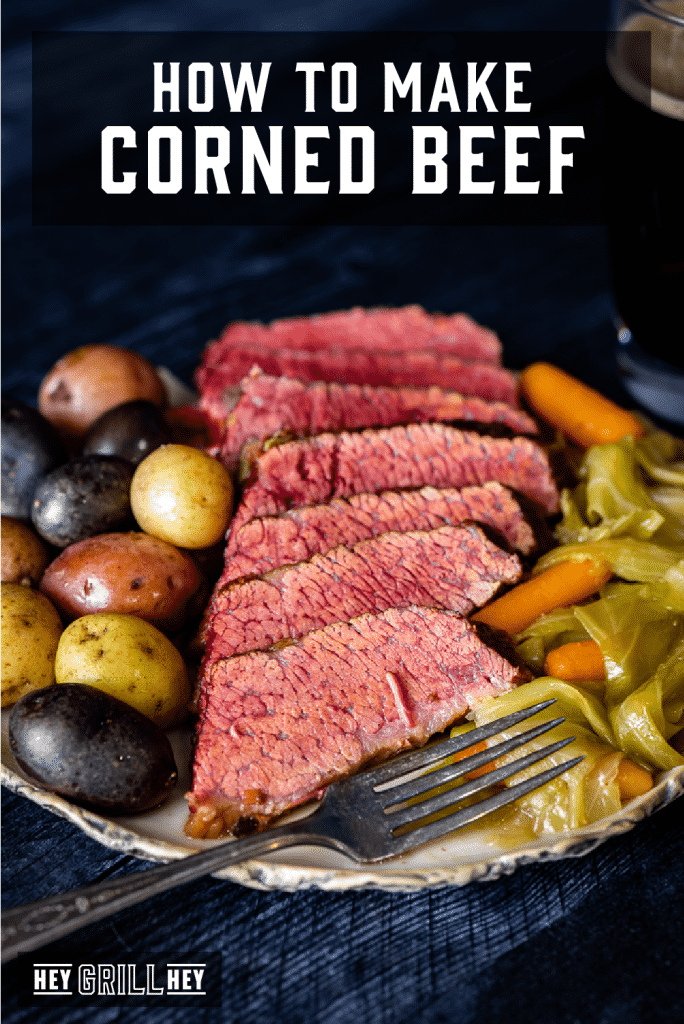
What is Corned Beef?
Corned beef is simply when a roast or brisket has been salt-cured with the optional addition of sugar and spices to the cure for added flavor. It’s often made from a tough beef roast (often a brisket or round roast) that has been slow cured and cooked to tender, salty perfection.
For this recipe I used a brisket flat and it worked perfectly, but you can use a brisket point or a bottom round roast as well. Brisket is a tough meat, but after 5 days in a bath of curing salt and a slow braise it will basically melt in your mouth (and taste incredible as well!).
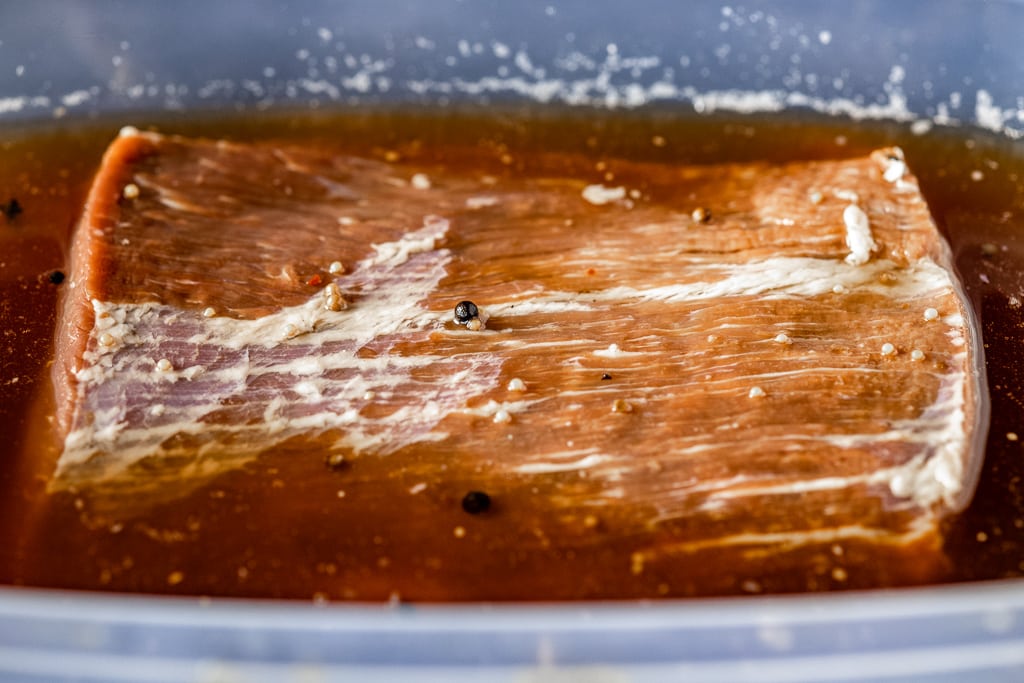
Home Cured Corned Beef
While you can easily purchase corned beef from the grocer (usually in March around St. Patrick’s Day), making your own is something I recommend trying at least once. The meat turned out extremely tender, juicy, and full of flavor that you won’t get from the store bought roasts.
Now, I’m not the first person to create a recipe for corned beef but that is the beauty of a brine recipe like this. Once you get the correct ratio of curing salt to meat, you can play with the spices and flavors to your liking. I personally love the sweet and spice blend I’ve got going on in this brine recipe. It makes every bite better than the last.
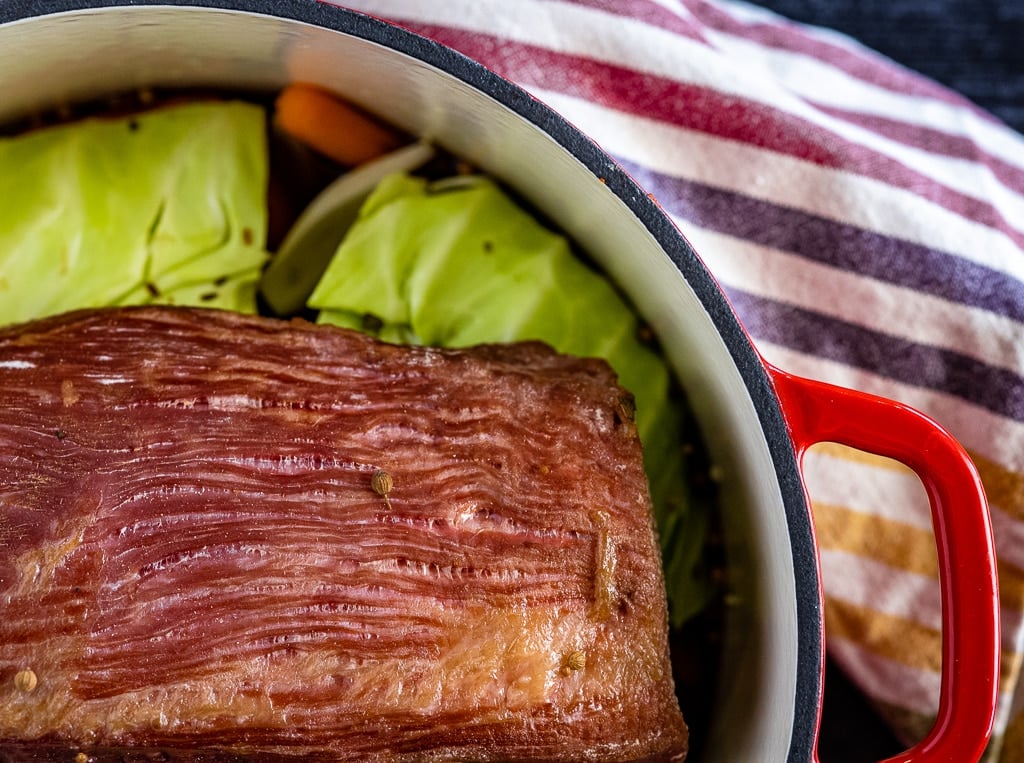
How to Make Corned Beef
Now that we’ve chatted a bit about corned beef, let’s get to the process. As mentioned, making corned beef requires you to cure a roast or brisket in a salt bath to render it nice and tender.
For this recipe, you will need Prague powder #1 (also called InstaCure or pink curing salt #1) in a ratio of 3.2 teaspoons cure per gallon of liquid for a 1.5 inch thick, 4-5 pound roast to get that deep pink color throughout your entire cut of meat.
- Make the brine. First up, you’ll want to make the brine using the Prague powder, water, apple juice, salt, brown sugar, and pickling spice. (Make sure to scroll below for the printable instructions with full ingredient amounts and instructions). Bring all ingredients to a boil in a large stock pot and stir well to dissolve all the salt and sugar.
- Cool the brine. Remove the brine from the heat, add 1 quart of ice and allow the brine to come to room temperature.
- Cure the beef. Place the beef brisket in a large, food-sage plastic container, and cover it in the brine. Place the brisket in the refrigerator and allow the beef to cure for 5-7 days. Turn and stir the brine mixture at least once every day.
That’s it! It’s definitely an easy process. All you need is a few good ingredients and some patience, and you’re on your way to making your own beef brisket!
Corned Beef Cure Ratios
Dry cures are often measured by weight of the meat your are curing. Typically 1 teaspoon will cure 5 pounds of meat. Since this is a wet brine method, the correct ratio will be the amount of cure suspended in the liquid. The correct amount of cure is crucial to making sure your meat is fully penetrated before cooking. If you have a different size of meat than I’ve used in this recipe, please refer to this awesome chart that gives you exact calculations of meat to liquid to brine. You simply input your weight, liquid amount, and size, and that chart will tell you exactly how much cure to use.
A thinner brisket flat will typically cure in 5 days, while a thicker cut (like a round roast) will take closer to 7 or 8 days. Another important tip is to rotate your meat in the brine and agitate your liquid every day. This prevents the salt from sinking to the bottom.
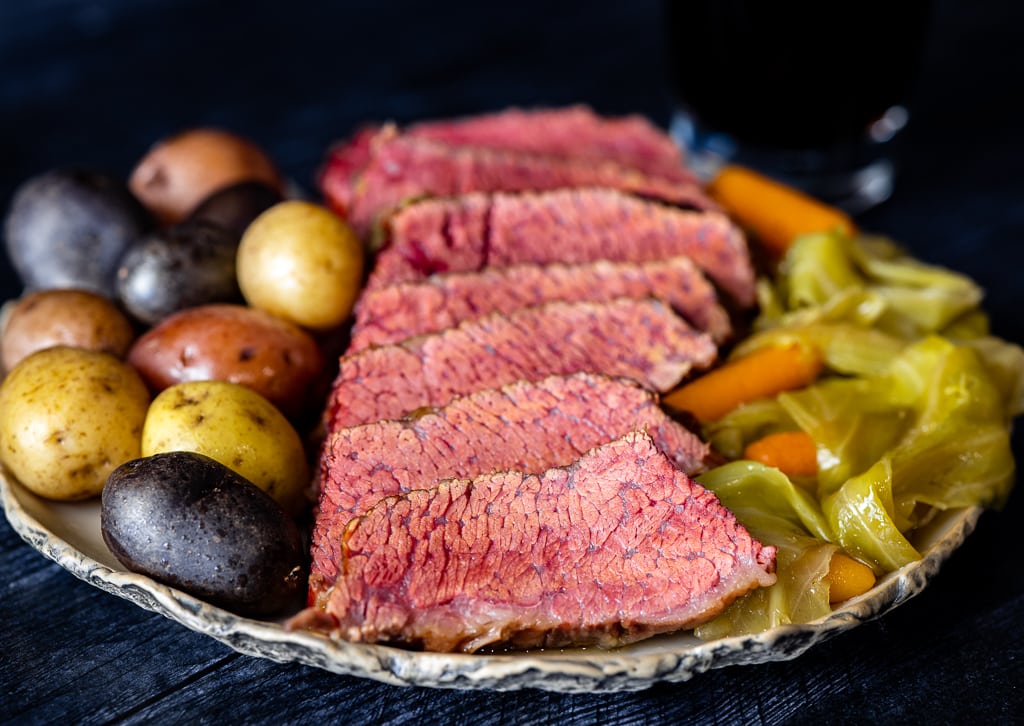
How to Cook Corned Beef
Once your beef is cured it’s time to cook! Traditional corned beef is boiled with the reserved pickling spices from the brine. That is totally an option!
My absolute favorite way to prepare corned beef is with my recipe for Smoked Corned Beef and Cabbage with the addition of braising with some delicious veggies. While this is not the most traditional way to cook corned beef, you’ll be shocked with how good it tastes! (Plus, I’ve never been much of a traditionalist anyways!)
More Corned Beef (and Cabbage!) Recipes
Whether you’re preparing for a St. Patrick’s Day feast, or you just have a hankering for some good food, these recipes will satisfy any craving.
Home Cured Corned Beef Recipe
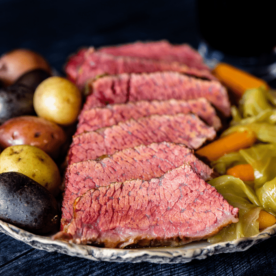
Home Cured Corned Beef
Video
Ingredients
- 1 4-5 pound whole packer brisket
Corned Beef Brine
- 2 quarts water
- 1 quart apple juice
- 1 1/2 cups coarse Kosher salt or sea salt
- 1/2 cup brown sugar
- 3.2 teaspoons pink curing salt #1 also known as Prague Powder #1. Ask your butcher or order online.
- 3 Tablespoons pickling spice
- 1 quart ice cubes
Instructions
- Make the brine. In a large stock pot, combine all of the ingredients for the brine except the ice. Bring to a boil and stir until all of the salt and sugar has dissolved in the brine. Remove from the heat and stir in the ice until the brine has cooled to room temperature.
- Cure the meat. Place the brisket in a large food-safe plastic container and pour over the cooled brine. Keep the brisket in the cure in the refrigerator for 5-7 days, turning and stirring the brine mixture at least once per day.
- Cook the corned beef. Once the brisket is cured, you can prepare as corned beef. (Recipe linked in the recipe notes.)
Notes
Nutrition
Nutrition information is automatically calculated, so should only be used as an approximation.
**This post was originally published in March 2017. We recently updated it with more information and helpful tips. The recipe remains the same.
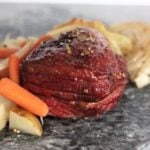


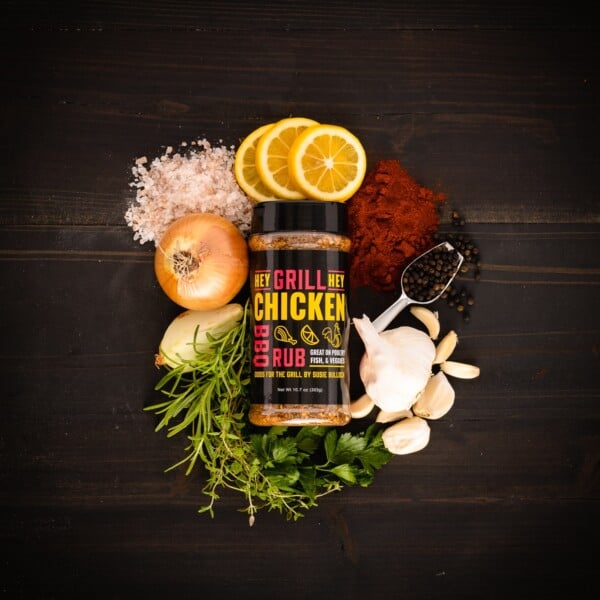
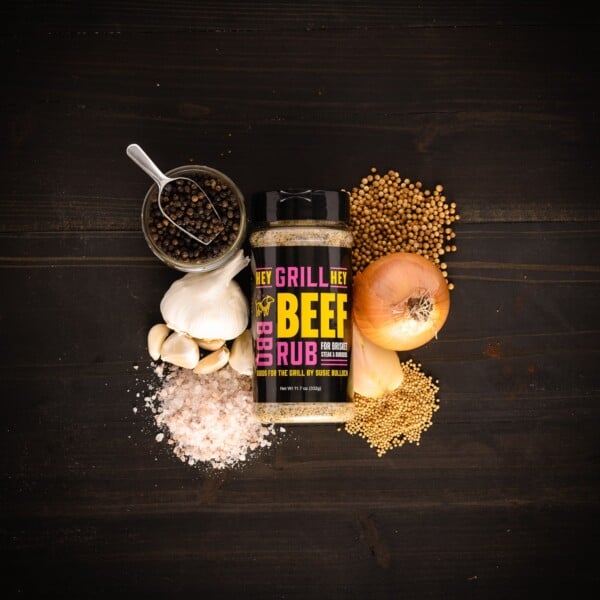
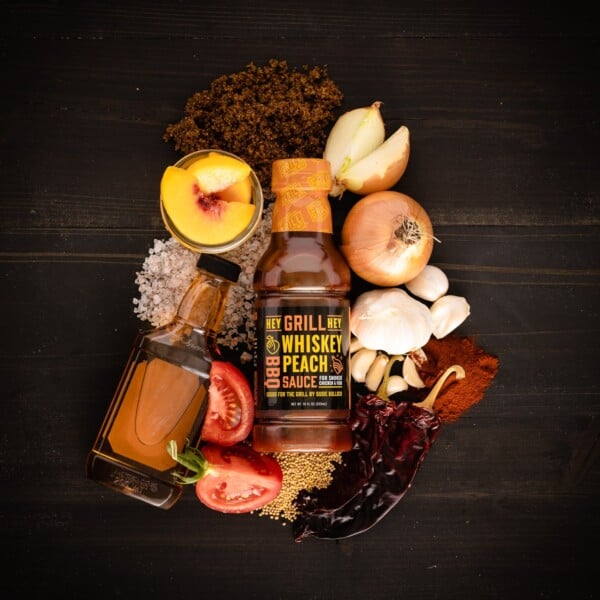


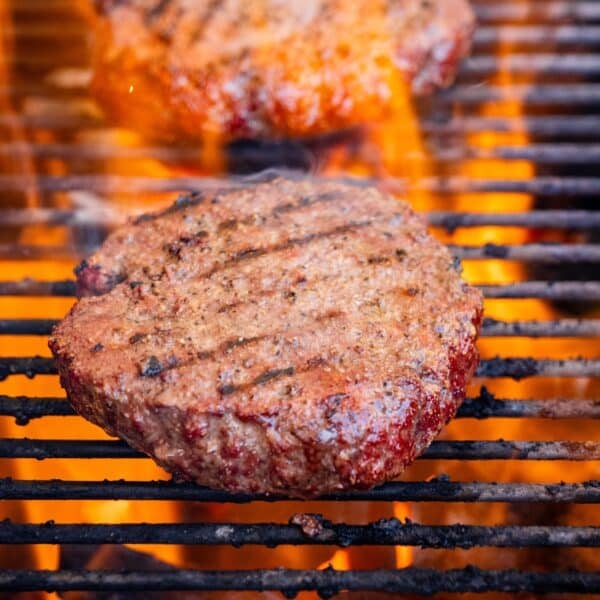







Could you cut the brisket flat in 2, stir good everyday, and use the same amount of cure#1? My flat wont fit in
one piece in My Container
The measurements on the cure are based on weight, so as long as the weight stays the same, it should be fine. If your pieces stick together in the cure or the liquid can’t float around evenly, it might cause issues. Keep agitating the liquid and rotating the meat frequently.
Did the pastrami recipe get removed from this article? It was here the other day now I can’t seem to find it right as mine is about to go on the smoker…
https://heygrillhey.com/homemade-pastrami/
I just realized I used Curing Salt #2 instead of #1 in the brine….is that going to be a problem?
It should be ok. The only difference between #1 and #2 is the addition of sodium nitrate.
Just tried your pastrami recipe with an elk roast and it is excellent. So good, that we already have two more cuts of beef in your brine now.
Thanks for the killer recipes!
can a similar treatment be applied to a poorer cut of pork?
Great work!… I just love your recipes. I did notice that you said you said you don’t rinse the brisket after its brind. Then adding another 2 tablespoons of salt to the pastrami rub won’t this make it way to salty?
May I use a tri-tip instead of brisket for making pastrami?
You can!
Question, should you rinse the curing solution off the flat before smoking? I tried a similar cure recipie once before and while it tasted good it was abnormally salty tasting. Always wondered if that was because I didn’t rinse the cure off. Love your recipies and your website!
I don’t rinse!
Suzie, 2 questions.1. After brining, do you need to soak the brine out of the meat? 2. since this a cure, how long will the corned beef last out of refrigeration? I can keep cool but not refriedgerated. (horse back, backcountry trip)
You don’t need to soak in water to remove the brine, but you can overnight if you prefer a less salty final product. In terms of food safety, even cured and cooked corned beef needs to be refrigerated. https://www.fsis.usda.gov/wps/wcm/connect/fsis-content/internet/main/topics/food-safety-education/get-answers/food-safety-fact-sheets/meat-preparation/corned-beef-and-food-safety/ct_index
Hi Susie,
Just did your Texas Brisket for Easter – amazing! Thinking about doing this pastrami – wondering about the “stall” and peach paper
Thanks!